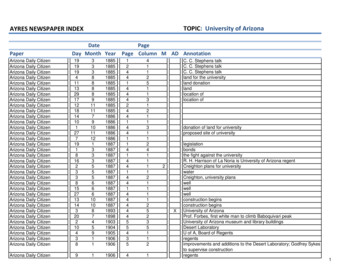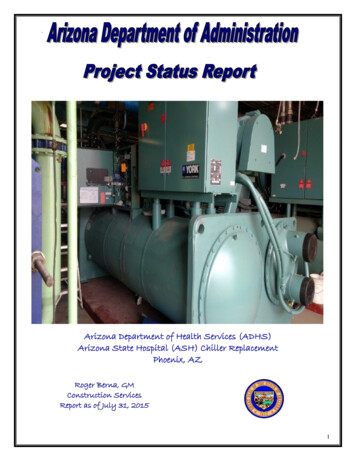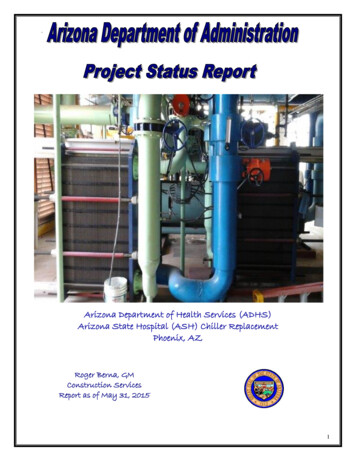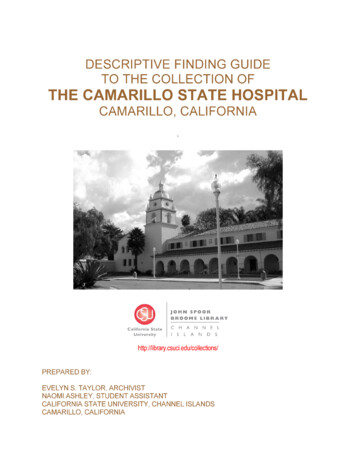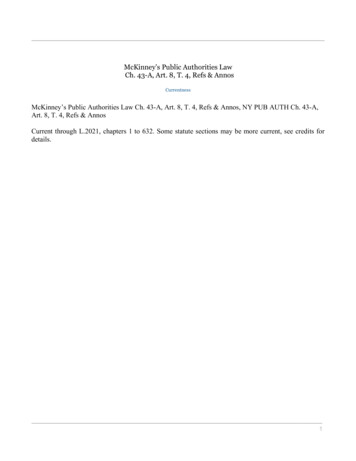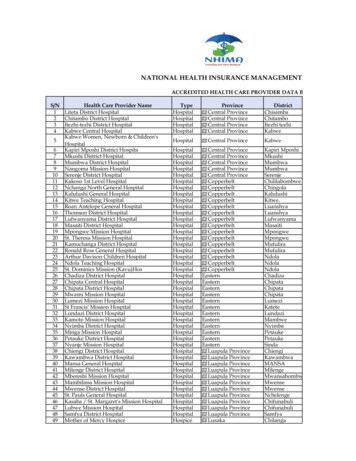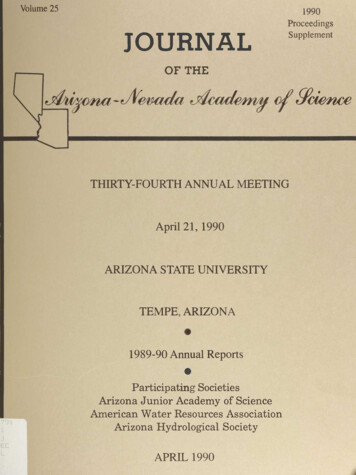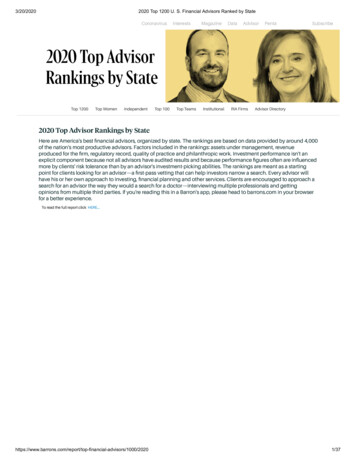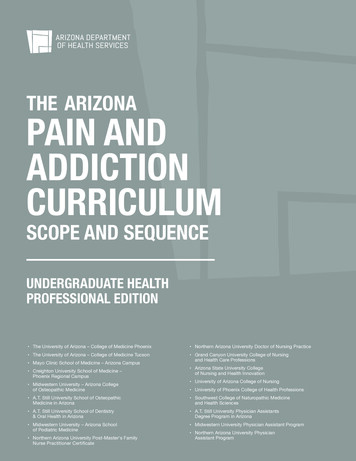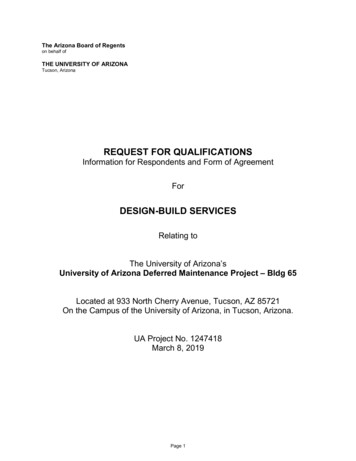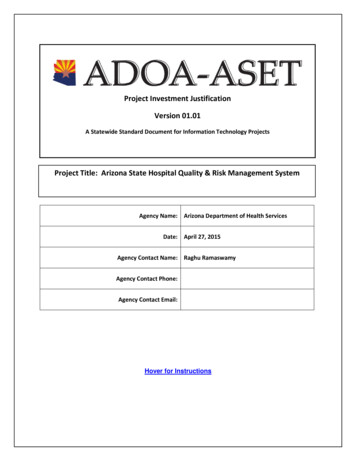
Transcription
Project Investment JustificationVersion 01.01A Statewide Standard Document for Information Technology ProjectsProject Title: Arizona State Hospital Quality & Risk Management SystemAgency Name: Arizona Department of Health ServicesDate: April 27, 2015Agency Contact Name: Raghu RamaswamyAgency Contact Phone:Agency Contact Email:Hover for Instructions
Arizona State Hospital Quality & Risk Management SystemI.Management Summary*The Arizona State Hospital (ASH) is a long-term, in-patient, behavioral healthcare facility that providestreatment services to the most seriously mentally ill Arizonans, as well as residents of the ArizonaCommunity Protection and Treatment Center (ACPTC). The Quality Resource Management (QRM)department oversees the quality and appropriateness of patient care through its Quality & RiskManagement program, which includes incident reporting and analysis. Incident analysis is a keycomponent of mandatory reporting to external entities, including The Joint Commission, the hospital’saccrediting body. The hospital’s Risk Management system is currently a combination of paper processesand automated systems that no longer meet regulatory compliance needs.The hospital has selected a third-party, Commercial-Off-the-Shelf (COTS) product called Midas Plus asthe solution to meet its Risk Management needs. Midas Plus is a product of the Xerox Corporation andis widely used in the health care industry. This Project Investment Justification (PIJ) is requestingapproval to purchase the software, hardware, and professional services needed to implement the MidasPlus software suite. All products and services will be purchased from existing State contracts.II.Project Investment Justification (PIJ) Type*YesXNo Is this document being provided for a Pre-PIJ / Assessment phase?If Yes,Identify any cost to be incurred during the Assessment phase.Based on research done to date, provide a high-level estimate orrange of development costs anticipated for the full PIJ. Explain:Click here to enter text.YesXNo Will a Request for Proposal (RFP) be issued as part of the Pre-PIJ or PIJ?Business CaseA.Business Problem*The QRM department collects and analyzes information about risk-related events that may affectpatient or staff safety. Certain risk events are classified as “incidents” and are reported through theincident reporting process. Examples of incidents include patient-on-patient assaults, patient-on-staffassaults, patient falls, and the use of seclusion and restraint. These types of incidents must be reportedto external governing entities, such as The Joint Commission. (The Joint Commission is an independentbody approved by the by the Centers for Medicare and Medicaid Services (CMS) to provide accreditationfor health care organizations that wish to participate in the Medicare program. Health careorganizations that achieve Joint Commission accreditation are determined to meet CMS requirementsfor quality and safety and are eligible to receive payments from CMS.)PIJ Form 2013-10-02Page 2 of 12
Arizona State Hospital Quality & Risk Management SystemQRM reports are used internally and externally to measure trends over time and for comparativeanalysis against other state psychiatric hospitals.The incident report itself is currently a fillable PDF form that is typically filled out by treatment unit staffand e-mailed to the QRM department. QRM staff must then enter the reports into the IncidentReporting Database (IRD). Other components of the risk process are filled out on paper forms, enteredinto the Avatar Electronic Medical Record (EMR) system, or kept in spreadsheets.The IRD was developed in Visual Basic 6.0 by a contractor and implemented in 2005; it has not beensignificantly modified since. The IRD interfaces with the Avatar EMR and with several Access 2003databases that were developed for reporting purposes. Attempts to make modifications to thereporting databases have resulted in failures that prevented critical reports from being generated. Thedata for mandatory reporting is now generated from various sources and compiled in Excelspreadsheets.Because of the number of data sources and duplicate data entry into various systems, the integrity ofthe data has become a significant issue. Data validation measures have been put into place but involvetime-consuming manual processes that divert QRM resources from the more critical functions of riskand quality of care analysis. Inaccurate data could compromise patient safety and puts the hospital atrisk of sanctions for non-compliance with regulatory standards. The current system of multiple manualand semi-automated systems is completely inadequate for an effective Risk Management program.Another component of Risk Management in a direct care setting is tracking Employee Healthinformation. Employee Health data tracks current immunizations, exposures, etc. Employee Healthdata is currently tracked in a series of custom-built screens within the Avatar EMR. These screens willnot be migrated to the new installation of Avatar scheduled for May 2015, in part due to time and costconstraints, and because the goal is to limit customization of the core product to the extent possible.Another solution for tracking Employee Health data is needed to avoid reverting back to a completelymanual system. Note: Prior to implementing Midas, Employee Health Records will either be kepttemporarily on paper and entered into Midas after go live, or the old Avatar system will be madetemporarily available for continued use only for Employee Health records.B.Proposed Business Solution*The proposed solution is to implement a comprehensive Quality and Risk Management softwarepackage, Midas Plus. The system is bundled into four functional subsystems: Registration, Encounter,Quality Management, and Risk Management, and includes a variety of other reporting and utilitysubsystems. The Risk Management subsystem contains a Risk Management module that will replacethe outdated Incident Reporting system, as well as an Employee Health module that will replace theAvatar data entry screens. These are the immediate needs. However, within the four functionalsubsystems are additional modules such as Infection Control, Patient Relations (Grievances andCompliments), and Peer Review, that together will deliver a complete Quality & Risk Managementsolution.Since the system is modular, functionality can be implemented all at once, or phased in. It is likely thatthe Risk Management (Incidents) and Employee Health modules will be implemented first, since thesePIJ Form 2013-10-02Page 3 of 12
Arizona State Hospital Quality & Risk Management Systemare the most immediate and critical needs, with Infection Control, Patient Relations and Peer Reviewimplemented shortly afterward. A final business decision on the implementation strategy will be madeduring Project Initiation; however, that decision will not impact the overall cost or timeline for theproject.The system comes with standard dictionaries, forms, and workflows that can be configured to meet thespecific needs of an organization. It also comes with a tool called Focus Studies that allows thecustomer to define custom data fields, forms, and performance indicators. Web-based dashboards,graphs, and trending tools are provided, as well as an SQL report writer for user-designed reports and aletter generating tool. The Midas Plus Statit Performance Indicator and Management Dashboard (StatitpiMD) application is also included in this proposal. Among the features of this Web-based tool are userdefined home pages that allow individuals to monitor indicators based on their specific job functionsand the ability to generate charts based on specified rule sets, as in the example below.Since the system isThis proposal includes Professional Services to assist with planning, installation and configuration of thesoftware and databases, interface development, and training. A maintenance agreement with Xerox willinclude software updates, database maintenance, and help desk support for users and technical staff.This proposal also includes the cost of two new servers (one for the production application and one fortest) and additional SAN storage to house the Midas Plus data. See Section III for additional details.PIJ Form 2013-10-02Page 4 of 12
Arizona State Hospital Quality & Risk Management SystemC.Quantified Benefits*XService enhancementIncreased revenueCost reductionProblem avoidanceRisk avoidanceXXExplain:Service Enhancement: Streamlining current manual efforts will free up staff time to perform qualityand risk analyses, which will benefit patients and staff. Improved ability to objectively assess the quality of care will enhance serviceto patients.Problem Avoidance: Decommissioning the existing IRD, which is over ten years old, will avoid apotential catastrophic failure.Risk Avoidance: III.Improved data integrity and reporting to external entities will reduce the risk ofpotential sanctions or penalties.Technology ApproachA.Proposed Technology Solution*Midas Plus Quality and Risk Management is a Microsoft .NET client/server application. The Statit piMDReporting Tool is browser-based and compatible with IE 7 and above. The database is IntersystemsCache, the same database used by the Avatar EMR and standard within the health care industry. Astandard HL7 Interface between Avatar and Midas will be developed for patient data that needs to becaptured in Midas. Security access is controlled by user IDs and passwords based on user roles.Two new servers will be purchased, one for Production/Training and a separate server for Test.Application and database updates will be installed in the test environment prior to installation inproduction and training. A SAN will be purchased to store the Midas data and any supportingdocuments that are scanned in. A maintenance contract will be established with Xerox for applicationand database support. Failover capabilities are provided through the Cache database journal files.PIJ Form 2013-10-02Page 5 of 12
Arizona State Hospital Quality & Risk Management SystemThe following hardware items will be purchased for this project: HP BLc7000 Platinum Enclosure with 1 Phase 6 Power SuppliesHP Virtual Connect Flex10/10D ModuleHP ProLiant BL460c Gen9 blade serversEMC e3200 SANB.Technology EnvironmentTechnology Environment:Currently, there is no infrastructure dedicated for MIDAS in the agency.The following technical environment, which has been reviewed with the vendor, will beestablished for the Midas project: One Application/Data Base Server will be purchased and configured with separatedatabase instances for Production and Training. A separate Application/Data Base server will be purchased and configured for theTest environment. This will allow application and database updates to be installedand tested prior to being promoted to the production and training environments. The servers will be located in the secure server room at the State Hospital. Additional SAN storage will be purchased and installed in the server room at ASH. Backups will be implemented using the standard ADHS NetBackup infrastructureand procedures. Failover is provided through Cache database journal files. The Avatar EMR environment is externally hosted in a fully redundant environmentwith DR capabilities. Patient demographic data will be securely transmitted fromAvatar to Midas through the dedicated MPLS established for the EMR. The Midas application is not mission critical (incidents can be generated in paperformat) and does not warrant the expenditure for a DR environment. Vendor connectivity to the servers for support will be provided through a VPNconnection.C.Selection ProcessASH considered four options and selected the fourth, Midas Plus, for the reasons cited below.1) Information Technology Services (ITS) considered converting the IRD to current technology andrebuilding the Access reporting databases in a SQL environment. Since the applications and data basesdo not meet current needs, this would have been a lengthy development project requiring additionalresources. This option was rejected.PIJ Form 2013-10-02Page 6 of 12
Arizona State Hospital Quality & Risk Management System2) The project team assessed the capabilities of the Avatar EMR Incident Reporting module. It wasdetermined that the core product did not meet the needs of the hospital and significant customizationwould be needed. In addition, it did not address the requirements for Employee Health.3) ITS provided a demo of an internally developed Incident Reporting system. The functionality wouldhave met the hospital’s need for incidents but did not address the requirements for Employee Health, orother aspects of hospital risk management.4) The hospital contacted and visited various hospitals that use Midas Plus, including those withbehavioral health facilities, and user satisfaction was extremely high. Several staff members currently atthe hospital have previous experience using Midas Plus at other facilities and highly recommend it. Thevendor provided an on-site demo to thirty staff from QRM, nursing, management, and ITS. Theconsensus was that it is a comprehensive, flexible product that will meet the Risk Management needs ofthe hospital.IV.Project ApproachA.Project Schedule*Project Start Date: 5/1/15B.Project End Date: 12/31/2015Project MilestonesNote: Dates are estimates only pending finalization of contract. Total project duration isexpected to be six months after the hardware is procured and installed.Major MilestonesProcurement Process – Hardware and SoftwareHardware/Software InstallationApplication Configuration and TestingEnd User Training & Go LivePIJ Form 2013-10-02Start Date5/1/156/1/157/1/1512/1/15Finish Date6/1/156/30/1511/30/1512/31/15Page 7 of 12
Arizona State Hospital Quality & Risk Management SystemV.Roles and ResponsibilitiesA.Project Roles and ResponsibilitiesJanet Mullen, Deputy Director, Division for Planning & OperationsThis position will be accountable to ensure resource availability at the Agency level and to meet thegoals within the budget and timeline. Monitoring business valueDonna Noriega, CEO, DBHS/ASH – Project SponsorThis position will provide approval for project scope. Specific responsibilities will include (but not belimited to): Project champion, provides direction and support to the team Approves project scope and funding Assigns appropriate end user resources to provide management decision making, end usertesting, training and requirements.Information Technology Executive – Paula Mattingly, Assistant Director / Chief Information OfficerThis position will be accountable to assign the necessary Information Technology resources to meet thegoals within the budget and timeline. Specific responsibilities will include (but not be limited to): Project champion, provides direction and support to ITS team Implement necessary Infrastructure and meet the immediate business needs Monitoring business value Management of IT staff or other resourcesChief Financial Officer – James HumbleThis position will be accountable to ensure resource availability at the Agency level to meet the goalswithin the budget and timelineITS Application Services Manager - Raghu RamaswamyThis position will provide overall leadership and oversight of solution delivery and efforts necessary toalign technology to meet the Department needs. This position will report to CIO. Specific responsibilitieswill include (but not be limited to): Coordinating resources assigned to the projectAssessing needs and bridging gap between Technical and functional needsDirect and delegate approved planProviding status reports to the Executive Management and GITA as requiredCoordinating the operational needs and performance troubleshooting and resolutionInformation Technology Project Manager – Janet SlawinskiThis position will provide leadership and overall project management and efforts described in thisdocument and for the future technology needs of the State Hospital. Specific responsibilities willinclude (but not be limited to): Coordinating resources assigned to the project Allocating resources to ensure project completion on schedule, within scope, and withinbudgetPIJ Form 2013-10-02Page 8 of 12
Arizona State Hospital Quality & Risk Management System Providing status reports to Executive Management and ASET as requiredCoordinating operational needsOversight of ImplementationChange control processes, issue trackingInformation Technology Technical Services Manager - David GilbertThis position will provide leadership and oversight for providing the technology needs to support theProject. Coordinate the delivery, installation, and configuration of hardware and software.Project Team:State Hospital: Functional experts will be assigned from QRM, Nursing, and Employee Health.Information Technology Services: Technical support staff will install and configure the hardware.Applications staff will assist with interfaces and reports.Vendor Responsibilities: Project management, software installation and configuration, training,ongoing support.B.Project Manager CertificationProject Management Professional (PMP) CertifiedState of Arizona CertifiedProject Management Certification not requiredXC.Full-Time Employee (FTE) Project HoursTotal Full-Time Employee HoursTotal Full-Time Employee CostVI.370 11,100Risk Matrix, Areas of Impact, Itemized List, PIJ FinancialsPIJ Form 2013-10-02Page 9 of 12
Arizona State Hospital Quality & Risk Management SystemVII.Project ApprovalsA.Agency CIO Review*Key Management Information1. Is this project for a mission-critical application system?2. Is this project referenced in your agency’s Strategic IT Plan?3. Is this project in compliance with all agency and State standards and policies fornetwork, security, platform, software/application, and/or data/information as definedin and-procedures, and applicable tothis project? If NO, explain in detail in the “XI. Additional Information” section below.4. Will this project transmit, store, or process sensitive, confidential or PersonallyIdentifiable Information (PII) data? If YES, in the “XI. Additional Information” sectionbelow, describe what security controls are being put in place to protect the data.5. Is this project in compliance with the Arizona Revised Statutes (A.R.S.) and GRRCrules?6. Is this project in compliance with the statewide policy regarding the accessibility toequipment and information technology for citizens with disabilities?B.YesYYNoYYYYProject Values*The following table should be populated with summary information from other sections of the PIJ.DescriptionAssessment Cost(if applicable for Pre-PIJ)Total Development CostTotal Project CostFTE HoursPIJ Form 2013-10-02SectionII. PIJ Type - Pre-PIJAssessment CostVII. PIJ Financials tabVII. PIJ Financials tabVI. Roles and ResponsibilitiesNumber or Cost 295,857 394,439370Page 10 of 12
Arizona State Hospital Quality & Risk Management SystemVIII.Optional AttachmentsA.Vendor QuotesIX.GlossaryX.Additional InformationThe Arizona Department of Health Services (ADHS) leverages administrative controls, technical controls,and physical controls to protect PII. To ensure the protection of all sensitive and confidential ArizonaDepartment of Health Services electronic data from unauthorized use, modification, destruction, ordisclosure, ADHS implemented multiple security policies. ADHS Information Security Policy frameworkwas created to enforce the rules and guidelines for the purpose of providing the confidentiality,integrity, and availability of all ADHS electronic information. All ADHS employees and contractors arebound by that Information Security framework which includes ITS-005 Acceptable Use Policy and sign aconfidentiality agreement. Training is provided for new work force members (employee’s andcontractors) and annually on Information Security and Privacy, which includes the Information Securitypolicies for ADHS and State of Arizona.The data created and stored in the Storage Area Network (SAN) is only accessible via Access Control Lists(ACLs) or Role-Based Access Control. ACLs are used to provide more granularity to users and groups filepermissions. ADHS uses a three-tier architecture comprising of front-end servers, middleware, andback-end databases.Multiple firewalls are also used to provide a line of defense from the outside. The first tier only acceptsspecified requests and will only authorize approved users to access the data. Access to the ADHS domainis controlled by the use of domain accounts. Database roles are also used in order to limit access toPIJ Form 2013-10-02Page 11 of 12
Arizona State Hospital Quality & Risk Management Systempreapproved users. Users are placed in groups that have implicit permissions necessary to perform theirduties.Links:ADOA-ASET WebsiteADOA-ASET Project Investment Justification Information Templates and ContactsEmail Addresses:Strategic OversightADOA-ASET Webmaster@azdoa.govPIJ Form 2013-10-02Page 12 of 12
into the Avatar Electronic Medical Record (EMR) system, or kept in spreadsheets. The IRD was developed in Visual Basic 6.0 by a contractor and implemented in 2005; it has not been significantly modified since. The IRD interfaces with the Avatar EMR and with several Access 2003 databases that were developed for reporting purposes.
